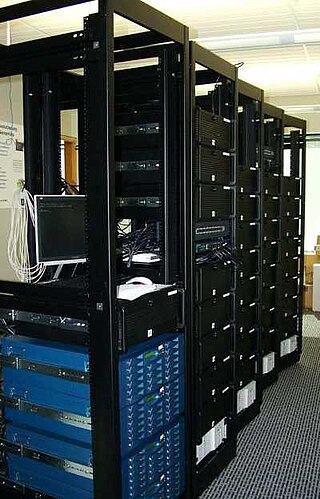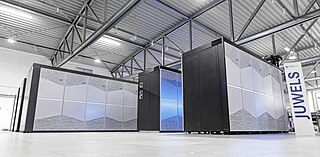
A supercomputer is a computer with a high level of performance as compared to a general-purpose computer. The performance of a supercomputer is commonly measured in floating-point operations per second (FLOPS) instead of million instructions per second (MIPS). Since 2017, there have existed supercomputers which can perform over 1017 FLOPS (a hundred quadrillion FLOPS, 100 petaFLOPS or 100 PFLOPS). For comparison, a desktop computer has performance in the range of hundreds of gigaFLOPS (1011) to tens of teraFLOPS (1013). Since November 2017, all of the world's fastest 500 supercomputers run on Linux-based operating systems. Additional research is being conducted in the United States, the European Union, Taiwan, Japan, and China to build faster, more powerful and technologically superior exascale supercomputers.

Celestial mechanics is the branch of astronomy that deals with the motions of objects in outer space. Historically, celestial mechanics applies principles of physics to astronomical objects, such as stars and planets, to produce ephemeris data.

Molecular dynamics (MD) is a computer simulation method for analyzing the physical movements of atoms and molecules. The atoms and molecules are allowed to interact for a fixed period of time, giving a view of the dynamic "evolution" of the system. In the most common version, the trajectories of atoms and molecules are determined by numerically solving Newton's equations of motion for a system of interacting particles, where forces between the particles and their potential energies are often calculated using interatomic potentials or molecular mechanical force fields. The method is applied mostly in chemical physics, materials science, and biophysics.
Newton's law of universal gravitation is usually stated as that every particle attracts every other particle in the universe with a force that is proportional to the product of their masses and inversely proportional to the square of the distance between their centers. The publication of the law has become known as the "first great unification", as it marked the unification of the previously described phenomena of gravity on Earth with known astronomical behaviors.
An approximation is anything that is intentionally similar but not exactly equal to something else.

A physics engine is computer software that provides an approximate simulation of certain physical systems, such as rigid body dynamics, soft body dynamics, and fluid dynamics, of use in the domains of computer graphics, video games and film (CGI). Their main uses are in video games, in which case the simulations are in real-time. The term is sometimes used more generally to describe any software system for simulating physical phenomena, such as high-performance scientific simulation.

In astronomy, perturbation is the complex motion of a massive body subjected to forces other than the gravitational attraction of a single other massive body. The other forces can include a third body, resistance, as from an atmosphere, and the off-center attraction of an oblate or otherwise misshapen body.
Numerical relativity is one of the branches of general relativity that uses numerical methods and algorithms to solve and analyze problems. To this end, supercomputers are often employed to study black holes, gravitational waves, neutron stars and many other phenomena governed by Einstein's theory of general relativity. A currently active field of research in numerical relativity is the simulation of relativistic binaries and their associated gravitational waves.

Norman Howard Christ is a physicist and professor at Columbia University, where he holds the Ephraim Gildor Professorship of Computational Theoretical Physics. He is notable for his research in Lattice QCD.

In physics and astronomy, an N-body simulation is a simulation of a dynamical system of particles, usually under the influence of physical forces, such as gravity. N-body simulations are widely used tools in astrophysics, from investigating the dynamics of few-body systems like the Earth-Moon-Sun system to understanding the evolution of the large-scale structure of the universe. In physical cosmology, N-body simulations are used to study processes of non-linear structure formation such as galaxy filaments and galaxy halos from the influence of dark matter. Direct N-body simulations are used to study the dynamical evolution of star clusters.
A logarithmic number system (LNS) is an arithmetic system used for representing real numbers in computer and digital hardware, especially for digital signal processing.
In computing, performance per watt is a measure of the energy efficiency of a particular computer architecture or computer hardware. Literally, it measures the rate of computation that can be delivered by a computer for every watt of power consumed. This rate is typically measured by performance on the LINPACK benchmark when trying to compare between computing systems: an example using this is the Green500 list of supercomputers. Performance per watt has been suggested to be a more sustainable measure of computing than Moore’s Law.
The Center for Computational Relativity and Gravitation (CCRG) is a research center of the College of Science (COS) and a Research Center of Excellence at Rochester Institute of Technology (RIT) dedicated to research at the frontiers of numerical relativity and relativistic astrophysics, gravitational-wave physics, its connection to experiments and observations, and high-performance computation and scientific visualization.

gravitySimulator is a novel supercomputer that incorporates special-purpose GRAPE hardware to solve the gravitational n-body problem. It is housed in the Center for Computational Relativity and Gravitation (CCRG) at the Rochester Institute of Technology. It became operational in 2005.

Japan operates a number of centers for supercomputing which hold world records in speed, with the K computer becoming the world's fastest in June 2011. and Fugaku took the lead in June 2020, and furthered it, as of November 2020, to 3 times faster than number two computer.

Computational astrophysics refers to the methods and computing tools developed and used in astrophysics research. Like computational chemistry or computational physics, it is both a specific branch of theoretical astrophysics and an interdisciplinary field relying on computer science, mathematics, and wider physics. Computational astrophysics is most often studied through an applied mathematics or astrophysics programme at PhD level.

Titan or OLCF-3 was a supercomputer built by Cray at Oak Ridge National Laboratory for use in a variety of science projects. Titan was an upgrade of Jaguar, a previous supercomputer at Oak Ridge, that uses graphics processing units (GPUs) in addition to conventional central processing units (CPUs). Titan was the first such hybrid to perform over 10 petaFLOPS. The upgrade began in October 2011, commenced stability testing in October 2012 and it became available to researchers in early 2013. The initial cost of the upgrade was US$60 million, funded primarily by the United States Department of Energy.

Summit or OLCF-4 is a supercomputer developed by IBM for use at Oak Ridge Leadership Computing Facility (OLCF), a facility at the Oak Ridge National Laboratory, capable of 200 petaFLOPS thus making it the 5th fastest supercomputer in the world after Frontier (OLCF-5), Fugaku, LUMI, and Leonardo, with Frontier being the fastest. It held the number 1 position from November 2018 to June 2020. Its current LINPACK benchmark is clocked at 148.6 petaFLOPS.
Edmond Chow is a full professor in the School of Computational Science and Engineering of Georgia Institute of Technology. His main areas of research are in designing numerical methods for high-performance computing and applying these methods to solve large-scale scientific computing problems.

JUWELS is a supercomputer developed by Atos Forschungszentrum Jülich, capable of 70.980 petaflops. It replaced the now disused JUQUEEN supercomputer. JUWELS Booster Module is ranked as the eight fastest supercomputer in the world. The JUWELS Booster Module is part of a modular system architecture and a second Xeon based JUWELS Module ranks separately as the 52nd fastest supercomputer in the world.













